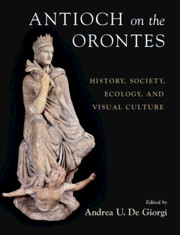Book contents
- Antioch on the Orontes
- Antioch on the Orontes
- Copyright page
- Dedication
- Contents
- Plates
- Figures
- Tables
- Contributors
- Abbreviations
- Antioch on the Orontes
- Part I Beginnings
- Part II The Making of a Capital
- Chapter 8 Antioch as a Provincial Capital
- Chapter 9 Building Programs and Natural Disasters
- Chapter 10 The City Walls of Antioch
- Chapter 11 Powerful Springs and Dangerous Torrents on Unsafe Ground
- Chapter 12 Housing in Daphne
- Chapter 13 The Antioch Mosaics
- Chapter 14 Coinage of and in Antioch in the Late Antique and Early Byzantine Periods
- Part III The People of Antioch
- Part IV Religion
- Part V Crises and Resilience
- Index
- Plate Section
- References
Chapter 13 - The Antioch Mosaics
History, Chronology, and Theory
from Part II - The Making of a Capital
Published online by Cambridge University Press: aN Invalid Date NaN
- Antioch on the Orontes
- Antioch on the Orontes
- Copyright page
- Dedication
- Contents
- Plates
- Figures
- Tables
- Contributors
- Abbreviations
- Antioch on the Orontes
- Part I Beginnings
- Part II The Making of a Capital
- Chapter 8 Antioch as a Provincial Capital
- Chapter 9 Building Programs and Natural Disasters
- Chapter 10 The City Walls of Antioch
- Chapter 11 Powerful Springs and Dangerous Torrents on Unsafe Ground
- Chapter 12 Housing in Daphne
- Chapter 13 The Antioch Mosaics
- Chapter 14 Coinage of and in Antioch in the Late Antique and Early Byzantine Periods
- Part III The People of Antioch
- Part IV Religion
- Part V Crises and Resilience
- Index
- Plate Section
- References
Summary
Since the 1930s, archaeologists have excavated over 300 mosaics at Antioch and its environs. This essay explores the developments and historiography on Antioch’s mosaics as well as new methodological approaches.
- Type
- Chapter
- Information
- Antioch on the OrontesHistory, Society, Ecology, and Visual Culture, pp. 207 - 224Publisher: Cambridge University PressPrint publication year: 2024



